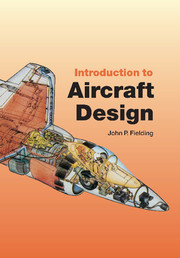Book contents
- Frontmatter
- Contents
- Preface
- Acknowledgements
- 1 Introduction
- 2 Why should we design a new aircraft?
- 3 Why is it that shape? – Civil aircraft
- 4 Why is it that shape? – Other types
- 5 What's under the skin? – Structure and propulsion
- 6 What's under the skin? – Airframe systems
- 7 What's under the skin? – Avionics, flight control and weapon systems
- 8 Why do aircraft cost so much?
- 9 What help can I get? – Bibliography and computer-aided design
- 10 The shape of things to come – Should the project continue?
- 11 What can go wrong? – Some lessons from past aircraft projects, and a glimpse into the future
- Appendix A Useful aircraft design data
- Appendix B A–90 parametric study. Example – the A-90 500-seat airliner
- Appendix C The prediction of aircraft reliability and maintainability targets
- References
- Index
Preface
- Frontmatter
- Contents
- Preface
- Acknowledgements
- 1 Introduction
- 2 Why should we design a new aircraft?
- 3 Why is it that shape? – Civil aircraft
- 4 Why is it that shape? – Other types
- 5 What's under the skin? – Structure and propulsion
- 6 What's under the skin? – Airframe systems
- 7 What's under the skin? – Avionics, flight control and weapon systems
- 8 Why do aircraft cost so much?
- 9 What help can I get? – Bibliography and computer-aided design
- 10 The shape of things to come – Should the project continue?
- 11 What can go wrong? – Some lessons from past aircraft projects, and a glimpse into the future
- Appendix A Useful aircraft design data
- Appendix B A–90 parametric study. Example – the A-90 500-seat airliner
- Appendix C The prediction of aircraft reliability and maintainability targets
- References
- Index
Summary
This book acts as an introduction to the full breadth of both civil and military aircraft design. It is designed for use by senior undergraduate and post-graduate aeronautical students, aerospace professionals and technically-inclined aviation enthusiasts.
The book poses and answers pertinent questions about aircraft design, and in doing so gives information and advice about the whole aircraft design environment. It asks why we should design a new aircraft and gives examples of market surveys and aircraft specifications. It then answers the question ‘why is it that shape’ and gives the rationale behind the configurations of a wide range of aircraft from micro-lights and helicopters to super-jumbos and V/STOL aircraft, with many others in-between. Having examined the shape, the book then examines and describes what is under the skin in terms of structure, propulsion, systems and weapons. Later chapters answer questions about aircraft costs and conceptual design and draw lessons from past projects and then look into the future. A major part of the book answers the question ‘what help can I get?’ It is a combination of bibliography, lists of data sheets, computer tools and 100 pages of appendices of design data vital to aircraft conceptual designers (most of it previously unpublished).
The book concentrates on fixed-wing civil and military aircraft, with some reference to light aircraft and rotorcraft, but does not address the design of sailplanes, airships, flying boats or spacecraft.
- Type
- Chapter
- Information
- Introduction to Aircraft Design , pp. ix - xPublisher: Cambridge University PressPrint publication year: 1999

